A very sound rule of thumb way to determine the goodness of a given make/model of car is to look around for them. If you see a lot of them around – especially older iterations of a given make/model – it is likely that make/model is a good car (or truck) and your chances of being saddled with a bad one – if you were to buy a used one – reduced signficantly.
Examples that come to mind immediately are cars like the see-them-all-the-time Toyota Corolla and Camry, going all the way back to the ’90s and beyond, even. It is almost impossible to not see a 15-20 year-old (or even older) Corolla on the road whenever you are.
Camrys, too.
The same for Honda Accords and Civics. You can probably summon other examples.
There are also contrary examples.
These are makes/models once prolific – you also saw them every time you went for a drive. But – now – you almost never see them anymore.
How about the Ford Taurus, for instance?
This car was a yuge hit for Ford back in the ’80s – right up there with Huey Lewis and the News. They were almost literally everywhere. Now you see them almost nowhere – excepting parts yards and the front yards of single-wides, with years of grass growing around them. This disappearing act is all the more interesting given that Ford built these things for 30-plus years, with production of the final iteration only ending in 2019 – and that’s only three years ago. Though – technically speaking – the last “real” Taurus was made in 2007. The ones that followed were rebadged Ford Five Hundreds.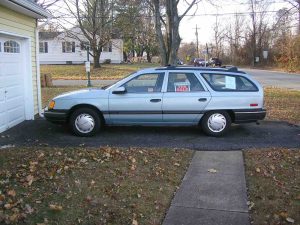
Still, it wasn’t that long ago. Where’d they all go? Millions were sold. More than a quarter-million annually during they heyday, back in the mid-late ’80s. The futuristic cars were hard not to see. Decades before Tesla, they featured a grill-less front end (air to cool the engine was ducted from underneath the bumper) and flush-mount headlights. It was a sleek, modern counterpoint to the boxy Ford LTD it replaced for 1986. And it was said to be a far better car, according to then Ford Chairman Donald E. Peterson, who said: “We are moving toward building a quality culture at Ford.” Some will recall the company’s slogan of the era:
Quality is Job 1.
It turned out to be maybe Job 3 . . . or four.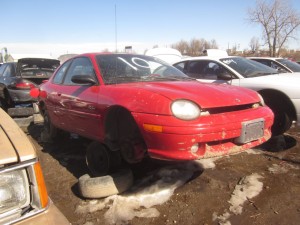
Though not a bad car, the Taurus was not a great car, as evidenced by the fact that despite being made in the millions, it’s rare to see an operational Taurus from the ’80s or ’90s these days. Whereas one cannot help seeing Corollas and Camrys from those days, these days.
Another example? How about the Dodge (and Plymouth) Neon? These small Mopars were built to compete with cars like the Corolla and Civic and for a number of years, back in the ’90s and early 2000s, they seemed to be doing just that and very effectively. Not encountering a Neon in those days was like trying to not get wet in a downpour. When the car was introduced for the ’94 model year, Chrysler’s president at the time, Bob Lutz, said the Neon would not be hobbled by the old Detroit adage that you can build a car to be “good, fast, or cheap. Pick any two.”
Chrysler apparently picked the latter two.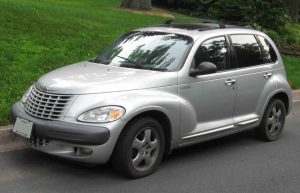
The Neon was cheap – and some (SRT) versions were quick – and that probably accounted for lots of people buying them. Also the later PT Cruiser, which was basically a custom-bodied version of the Neon made to look kind of like a 1930s hot rod but which was also much more practical than the Neon sedan and coupe, having much more interior space, especially for cargo. The PT Cruiser version of the Neon was so popular that GM hired away one of its chief designers and built a copy, the Chevy HHR – which you also almost never see anymore, even though Chevy made them as recently as 2011.
One must also speak of the Chevy Cavalier, another small car made in mass quantities that has become as rare a sight on the road as a Stutz Bearcat. The reason you almost never see operational Cavaliers anymore is due to the fact that most aren’t – on account of such built-in design problems as serially leaking cylinder head gaskets and rapidly disintegrating plastic.
Back to the good ‘uns. Which – again – you can tell by sight. How often do you see an ancient but still looking-good Lexus RX or LS sedan? Probably the last time you went for a drive or parked next to one at the supermarket.
And while you may have noticed a trend, it’s not a universal one. While most of the cars made by the Big Three over the past thirty years have come – and gone – it is a different story as regards the trucks made by them. One sees even older examples of Chevy and Ford half-tons as commonly as one sees Corollas and Camrys of similar vintage. A mid-late ’80s F-150 with the straight six and a manual transmission is as Methuslean a machine as you’ll find.
And the fact that you can still see them is the proof of that proverbial pudding.
. . .
Got a question about cars, Libertarian politics – or anything else? Click on the “ask Eric” link and send ’em in! Or email me at EPeters952@yahoo.com if the @!** “ask Eric” button doesn’t work!
If you like what you’ve found here please consider supporting EPautos.
We depend on you to keep the wheels turning!
Our donate button is here.
If you prefer not to use PayPal, our mailing address is:
EPautos
721 Hummingbird Lane SE
Copper Hill, VA 24079
PS: Get an EPautos magnet or sticker or coaster in return for a $20 or more one-time donation or a $10 or more monthly recurring donation. (Please be sure to tell us you want a magnet or sticker or coaster – and also, provide an address, so we know where to mail the thing!)
My eBook about car buying (new and used) is also available for your favorite price – free! Click here. If that fails, email me at EPeters952@yahoo.com and I will send you a copy directly!


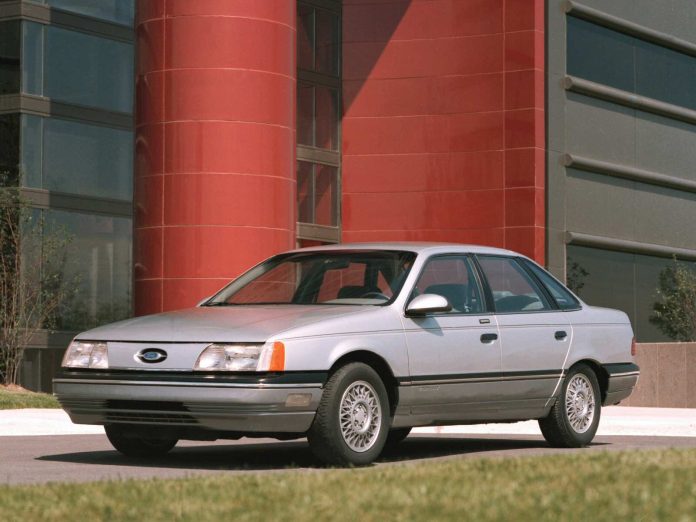

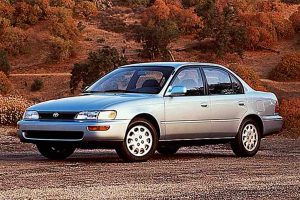
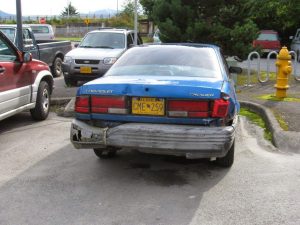







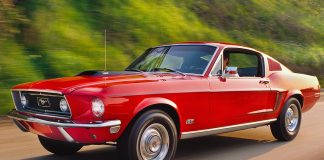
Eric, I won’t dispute you that you’ll see a LOT more 80s and 90s-vintage Hondas and Toyotas (and don’t forget the SUBARUs) than virtually anything else, save for “Murican” pickups, especially those that were NOT “Cowboy Cadillacs” of their time.
But there’s a bit more involved with that long-range success than build quality, though, again, undeniably, the better-quality Jap stuff was simply better made. It was WHO bought them, and who STILL drives those vintage Jap rides today. Answer: mostly OLDER people.
By the mid-1980s, many aging Americans were absolutely turned off by gas-guzzlng Detroit iron that, while some of the older RWD models, like, say, a Chrysler Fifth Avenue with a 318 four-barrel (the only Mopar V8 available in passenger cars after ’83), had bulletproof engines and transmissions, the build quality of even the “top shelf” stuff was….SHIT. Switches broke off, doors and hoods were mis-aligned, cars were delivered with defects in the tens and even HUNDREDS. It was a period of labor unrest in Detroit and much politicking going on, with labor and management not only fighting each other, but each appealing to Washington to intervene. This also drove even greater efforts to automate, using robots where human labor once was dominant, but the technologies were new and not well-understood, creating a vicious cycle of poor quality control and lost sales.
Meanwhile, the Japs had been SMART. They actually lost money on some lines, due as much to tariffs and currency fluctuation, but they persevered, as to them, “Business is WAR.” Toyota, Nissan, Mazda, and Honda may not have actually made a lot of money on their USA sales in the 70s, but they gained the most fickle of things…LOYALTY. The older guy that had bought a new Honda Civic for his daughter to go to college with in ’76 was likely impressed with it; and when he went into an Honda stealership and looked at Accords in ’86, he likely bought as they were more “solid” than the Buick or Mercury he was contemplating. He probably drove that thing as his main ride for about 15-20 years, kept it lovingly in the “gay-rage”, and had it serviced faithfully, and it rewarded him without having any major problems…sure, he paid through the nose for a brake job, but at least the thing fires up on command. By now, he’s retired, and wifey probably has a late model Lexus or Toyota crossover vehicle, but as he’s happy with the old ’86 Accord, it’ll get him around town when he needs to get out…which isn’t all that often. It’ll be a good guess as to whether car or driver expires first.
I say, THAT is why you see more of these vintage Jap rides; they wouldn’t survive the abuse that most idiots inflict on them, either, but if someone takes good care of them, the car will return the favor.
Cars (and trucks) I still see a lot of:
1. 1990’s Buick’s: In fact I probably see more old 90’s Buick’s than new ones. A few of my older neighbors have (or had before they passed away) 1990’s Buick’s that most bought new. All garage queens with low miles. Some would like a newer Buick but aren’t interested in what they sell today. On another note, a co-worker (she is 25ish) is driving what was her grandparents Buick Century before they quit driving. Unfortunately it is deteriorating due to her not having a garage. Most I think have passed from the hands of the original buyers now.
2. 1990’s-2000’s Toyota and Honda sedans. Another co-worker has a late 1990’s Corolla. He to is losing a rust battle (no garage either) with his as well.
3. 1990’s-2000 GM Ford and Dodge pickups. Lots of the Dodge ones are rough, as they seem to rust more than the other brands. Loads of 1990 GM ones seem common round here.
4. 2001-2008 Ford Focus’s. You don’t see nearly as many of these as the Toyota and Honda models from the same era, but they seemed to outlast the GM and Dodge ones as you don’t see those at all. I had a 2002 until 2 years ago. They were far better than Neons and Cavalier but of course still lagged the Japanese.
Not really a particular model, but around here we have steel mills. Most of the people working there have a beater to go there to work. They do have newer and nicer cars but you don’t take them to work as they will get damaged.
1,2, and 3 are typically driven by older folks, and reflect my prior comment (see above).
4? Foci? Really? I will say the vintage of “Foci” in the “aughts” were far better than the abominations they foisted on the car buying public from 2012-2018 with that “dual clutch” transmission.
Love the 90s Buicks. My first car was a ’92 Century, and I’ve had a ’91 and ’96,’ as well as it’s sister in an ’88 Cutlass Ciera. Those things could take a beating and were reasonably efficient.
Every so often I look to see if there are any good deals, particularly on a wagon, but I don’t find too many for sale. Low mileage vehicles go for more than you’d think given how many were made.
In Az’s Yavapai County, you also see a huge number of Crown Vics and Mercury Grand Marquis (what’s the plural of “Marquis?)
Plus, a bunch of full length GM Suburbans ( aka “BMWs” to our LDS friends.)
What’s surprising is how many Ford Flexes you’ll find. Not especially old. But a lot of them look like they’ve been Ridden Hard, and still on the road.
.
About six months ago, I saw a mint Ford Escort heading down the highway. It wasn’t an old lady driving though I suspect one died for that driver to be driving it.
I had a Ford Fucus not so long ago for work that everything fell apart as if on cue to fail at 150k. I turned in a 4 door Fucus with only one outside door handle still operational. Had to leave the windows down all the time.
Remember the Taurus’ predecessor? The Tempo? My earliest memories of Los Angeles as a kid was landing at LAX and getting into a Ford Tempo on my first visit. “It’s aerodynamic!”. That night was also the first time I ever ate a taco from Taco Bell. 80s, flying to LAX, Ford Tempo, tacos!, SOLD! Quite interesting that a little later in life, I would learn how to drive a manual transmission in Georgia because my mom said we wouldn’t get home from my 1st job that night until I learned to drive the manual transmission truck when she picked me up that great and awesome night. Then later that summer, in LA, I learned how to drive and not piss other drivers off in a ’79 Celica, manual tranny of course.
And mention was made of the Ford and Chevy trucks of the era, but where are the Dodges? I don’t remember Dodge fondly during this era.
And of that era, there was the sexy Jaguar Xj6. A pair were used in a Whitesnake music video. My mother wanted one more than anything. In LA, I saw a Jag Xj6 limousine. I thought it was wild. Have you seen a Xj6 lately? Much less a limo version?
I had actually bought a Taurus Wagon when I was a broke-ass fool living in San Diego. And whattaya know? It blew a head gasket within a week. The guy I bought it from was a friend of a friend, so he let me off the hook. I actually liked the practicality though I’m not the hugest Ford fan. I would’ve used that wagon for quite some time otherwise.
I knew a guy whose parents owned an actual Stutz. A very beautiful machine. My friend’s dad was the actual “Mr Gasket”, not that’s a huge deal but seemed to make them very rich.
Those HHRs look kinda cool TBH. But looking at the specs, they’re way underpowered for me. They look nice though.
And speaking of older cars that nobody sees anymore. My favorite Audi of all time is the A6 Avant. I had three of ’em… an old one (2002) is in the driveway at the moment. Audi inexplicably discontinued the A4/A6 Avant in the US though they continue to sell them in Europe to this day. I went to Europe in 2019 before corona hoax and I saw them left and right. All over the place and not just A4/A6 Avants but also A3/S4/S6 Avants… ALL OVER THE PLACE especially in London. Kind of pisses me off TBH.
I’m gonna sell my A4 Allroad… an almost Avant but stupidly “ruggedized” and which stands zero chance to ever be a practical offroad vehicle. As soon as the sunroof gets fixed… off to auction. I’ve had it with Audi.
But anyway, good luck finding an Avant. They were sold in the USA until 2012 (IIRC). Now they’re unicorns and, if you find them — outside of rare circumstances — they’re beat to hell and soon to land in the junk yard like my two ’97 A6 Avants did. My ’02 probably doesn’t have long to live either.
I’ve had a few Tauruses as company cars, and even owned a sable wagon. They were OK, which is about all I can say about them. Not unpleasant as a company ride.
I’d get Big 3 cars as rentals all the time when I traveled. Some were OK, some sucked. Mostly the GM models. Whiney transmissions, slippy in turns, couldn’t decide what gear it wanted to be in when I was on the highway.
I haven’t owned an American car in years. I’ve had Toyota mostly with a few Nissans and a Honda thrown in. They’ve all been flawless.
Once, when I took our Sienna in for service they gave me a Corolla with the sticker still on. I’m thinking this was early 2000s. The thing’s sticker was $12800. I was smiling driving it, and thought, man if I only paid that I’d be grinning every day.
Jap car companies expect a car to be profitable, or it isn’t made or exported. Whereas the Big three will build crap to lower their CAFe to get the sweet sweet truck and muscle car profit. That being the case, they put the same care and attention to detail in all their models. That loaner corolla was kitted out just as nice as my Sequoia.
That said, there are Toyota models that are even more eyebrow raising. the ’94 vintage Camry comes to mind. I still see them on the road. Hell, my neighbor down the street has a ’95. I see ancient Corollas every day.
But they have their ‘edsals’ as well. You know what I never see? A Prius that’s over 10 years old. I’ve seen one, and it had a different color door and was CLEARLY running on it’s clapped out gas engine.
I see a surprising number of Saturn Vues, mostly second generation. Don’t know why, I’m not really looking for them but I usually notice the badge first.
Of course there are almost no other Saturns on the road anymore, that “different kind of car company” still was part of GM’s accounting department and still made sure they’d need replacing.
I still have one. 4 cylinder, manual transmission, 276,000 miles currently my daily driver. Engine has never needed work, Oil changes with the seasons, four times per year regardless of mileage. Changed wheel bearings myself along with other minor suspension components. Best car I have ever owned…
Honda engines and transmissions in the V6 Vue after a certain model year, definitely before the second generation.
The 80s redesign Thunderbird and Cougar used to be everywhere too, especially the Cougar around Tampa when the Lincoln-Mercury dealers were making obscene amounts of money thanks to the Town Car.
What finally killed the Cougar was the redesign using what would have been the third gen Probe.
I heard that Saturn Vue automatic transmissions were problematic. Glad I have a manual…
I still see plenty of old Geo Metros, being really a rebadged Suzuki Swift. The Metro is a cheap car, but they are still being made road worthy because of the incredible gas mpg, over 50 if you know what you are doing.
There was a Stutz Bearcat legend in North Idaho. My friend at the old Sagle Flea Market would tell this story over and over: a couple of hunters from Couer D’Alene stumbled upon one in an old run down shack way back in the woods, but they didn’t know what it was. After they returned home they looked it up, it was a very valuable Stutz Bearcat, and then decided to go retrieve it, but when they returned the next weekend they couldn’t find the old shack.
——————-
But someone did find a barn full of them:
Incredible Cache Of Stutz Automobiles
Found In Barn, Outbuildings
A.K. Miller collection
https://www.coolcatcorp.com/millerauction/MillerAuction.html
https://vtauto.org/a-k-miller-hcs-stutz/
https://www.christies.com/en/auction/a-k-miller-collection-of-motor-cars-5308/
FYI: something called Wordfence is telling me I am blocked from logging in.
The login from an article hangs the login to the comments page results in a generated page that says:
“Your access to this site has been temporarily limited by the site owner
Your access to this service has been temporarily limited. Please try again in a few minutes. (HTTP response code 503)
If you think you have been blocked in error, contact the owner of this site for assistance.”
(…)
Block Reason: You have been temporarily locked out of this system. This means that you will not be able to log in for a while.
However it hasn’t resolved itself in a couple hours now.
Same thing from multiple browsers. I may be the only one with this issue since others are commenting. But maybe it’s more.
Hi Brent,
I’m checking into this; can you log in now?
re: eric October 6, 2022 At 2:39 pm
Same deal from home as from work earlier. Login from top banner is stalls. Block page if I try to login to the comments reading page.
Thanks, Brent – I am checking into it… stay tuned!
I can’t log in also.
Yeah: I hear that those Ford 300 cu in straight sixes are *still produced* for aircraft tractor tugs! My 90 Taurus wagon with the 3.0 Vulcan went for almost 200k miles. No big problems (alternators, water pumps) but anything that hangs off the engine is okay by me. Eventually, it wouldn’t idle. I think I got the idle air control valve replaced, but even the replacement kept opening too wide… I guess it was just doing what it was told…
That’s the problem, the engine controls are one big feedback loop. When it works, it’s great, but if the feedback loop gets outta whack then fixing it is a nightmare
My wife owned a 96 cavalier that we traded in for her on an 01 Taurus, which we traded in 06 on a new Caddy SRX (worst car for initially quality I ever owned, stranded us a few blocks from home when only 3 days old). For us and others in Gen X in our social milieu at the time I imagine, these were kind of the “real adult” cars you owned after your learner jalopy but not yet the aspirational (hahaha) luxury cars and SUVs that followed. Nobody I knew kept cars more than 5-7 years back then. Older Cavaliers and Tauruses became learner jalopies. It was an interesting circular system.
A “Stutz Bearcat”? You must have watched the episode of Green Acres on MeTV last night – the one where the Douglas’ decide to send Eb to college (without knowing that he didn’t even graduate from HS.
I definitely see lots of 2000s Ford and Chevy pickups, particularly the 3/4 and 1/2 ton versions. Even the ones that do hard work hold up—even though they don’t look nice.
The same is true of Toyota trucks: you can’t kill them. What does them in is rust—the body and frame go well before the mechanicals. I also live in a place that gets snow, so I see tons of older Subaru Outbacks, Forestsrs, and Legacies. Like Toyotas and Hondas, they go because of body and frame rust. I gave up my 2003 Outback after 13 years when it failed inspection due to rust-through.
I second that I also see a lot of Buicks with the 3800/3.8L V6, of any body style or model. I think one factor besides the solidity of that engine is that said Buicks are bought by older folks who tend to take care of them and drive them conservatively. Whereas many Pontiacs with the same engine were driven by younger people who may not have maintained them as well or drove them aggressively.
A key factor, I think, that these vehicles have in common is owner loyalty and trust in the product. That loyalty is EARNED because these products are built well, not too expensive to buy, maintain, and fix, and especially because their owners don’t see them as “disposable,” hence they take better care of them.
I know many people who own these vehicles, and they are “in love,” for lack of a better word, with them. I can see how one might “fall in love” with their F250, LeSabre, Outback, Camry, Civic, etc. because these vehicles are built well, perform reliably, and provide a decent driving experience. I can’t see anyone falling in love with a Ford Taurus, Chevy Cavalier, or Dodge Neon. These vehicles actually seemed to penalize their owners for buying them with poor build quality, unreliability, poor resale value, and an unexceptional if not unpleasant driving experience.
That’s what I think happened to all those Tauruses, Cavaliers, and Neons—they were popular, but not really loved by buyers.
Probably a better example of a Ford you don’t see any more is the Contour, not a half-bad vehicle when new but way low on longevity and repairability.
The Taurus was a fantastic car engine-wise and many went 200K or more miles, but in the North they rotted out by that point. Some years had transmission issues. If your trans went at 198k and the wheel arches and rockers were rusted… you didn’t fix it, you scrapped it.
Recently I saw a guy driving a 79-80-ish Chevy Citation as a daily driver, and thought, “Wow… that’s something you don’t see any more every day.” Reminded me of how OLD I am getting, seems like yesterday those things (along with Chrysler K-cars) were common as dirt, but somehow 40 years went by…
Lots of BMW E30’s around still, lots of older VW Golfs on the road still and old air cooled beetles, you still see older Volvos around, considering their production numbers there is still quite a few Porsche 944’s around.
The king of them all is the 911, a higher percentage of them are still being driven then any other car, for one they were galvanized, more importantly they are very well made and engineered, fantastic to drive and are collectible, so worth lots of money (air cooled better), so people will pay to restore/maintain them.
The 924 was a fantastic car but didn’t go up in value till recently, so owners wouldn’t restore them, they were scrapped.
with high fuel prices this car should be popular (one of the best cars ever made)……..Ice diesel cleaner then an EV
The 2014 Volkswagen Golf BlueMotion diesel, capable of a claimed 88.3 mpg imperial, or 73.5 mpg U.S.
it has a 971 mile range, the perfect car.
The Volkswagen Golf BlueMotion has emissions of 85g CO2 per km. it is even cleaner (less emissions) than a Toyota Prius or an EV….
A bloomberg article states, “A current-model large EV car with a battery produced and charged in an average European Union country emits about 88 grams of CO2 per kilometer,
new EV’s get 20 mpg….lol
2014 Volkswagen Golf BlueMotion for sale… $6403.00….buy one…
https://www.motors.co.uk/volkswagen/golf/trim/bluemotion/year/2014/used-cars/
Just yesterday I saw an early 90s or late 80s Volvo. I couldn’t get a good look at the back, but I want to say it was a 240 model. And it was in pristine shape. Shiny white and no rust.
I’ll still see a few Le Baron’s too, believe it not. Maybe the owners think that Jon (or John) Voight was the previous owner?
There are the Tauruses and the Neons…which were cheap and boring….and while not necessarily bombs mechanically, they weren’t stellar high-mileage vehicles either. When the tranny in the Taurus or the head gasket in the Neon blew, you threw the car away, ’cause who wants to put good money into a non-stellar boring transportation appliance? They’re the kind of cars that the owners are generally happy to have something major go wrong with, so they can get something else.
Then there are the cars that offer a little more and are loved by their owners…but are dogs mechanically, and age like fine milk- These are cars like Volkswagens. How often does one see a ten year-old VW these days?
The Toyotas and Hondas….they have it together. Even the cheapest models tend to be loved, as the quality is apparent every time yoiu drive ’em, AND they are mechanically superior- so both of those factors insure that they will live long lives and be maintained and repaired and lead many lives as used vehicles.
Back in the 80’s, the ‘Yotas and Hondas were already mechanically great (Actually, more so than today- as they were much simpler)…trouble was, back then they’d rust away, so you wouldn’t see ’em around after 8 or 10 years. I picked up many for scrap in NY in the 90’s…they’d often have several hunnert thousand miles on ’em, and still be running fine…but the bodies would be swiss cheese. Once they got the rust under control….they were unbeatable.
The absurd thing is, when new, the good Jap cars (not to be confused with the lesser Jap cars, like Mitsubishits, etc.) cost little more than their American counterparts. I never understood why it is that someone’ll buy some Chrysler POS (or other lesser brand) that’ll depreciate faster and die sooner, when they could just buy the superior Jap car for often only $1000 more. That grand will be more than recouped when one sells the Jap car- or, if they never sell, it’ll be an even better deal when the Jap lasts for 30 years, while the Chrysler dies before 10 -and not even to mention the difference in repairs that the Chruddler will require vs. the Jap……
Just get something w/o computers.
Even though they made over a million of the last-generation Town Car my mechanic had to resort to eBay to get parts.
The driver’s door sensor failed which blew out the central locking module (no power locks, remote or in-car) & the driver’s side seat adjustment module.
So far my mechanic was only able to find the central locking module, used, off eBay.
No keypad access though…that code has to be programmed by the dealer.
And the only way to adjust the power driver’s seat right now is to go to my mechanic and have them use their professional, 5-figure scan tool to access it.
Remember the “cash for clunker” program?
Many decent cars were destroyed “just because” uncle sam said so…
Until cash for clunkers many 1990’s cars were still very common around here. They vanished over night it seemed.
A friend of mine had a friend who turned in her Fox body 5.0 Mustang in the cash for clunker program.
What an idiot!
I think there’s a disposable element to the Cavalier, Neon and even the Taurus. The Taurus was a reliable car, but it was not loved by its owners. Hence when it came time for big repairs, such as replacing the engine (the Vulcan V-6 was a very craptastically weak, yet reliable pushrod engine) or transmission, people junked those cars. You still see some SHOs and that’s because they were otherworldly with that free-reving Yamaha built V-6 and a proper manual transmission.
Ford ruined the Taurus when they made every bit of it, even the audio and climate controls, ovoid to the point of the absurdity. The DOHC motor in those cars was very strong, but the styling was weird to the point of the absurdity. After that, they were lapped by the Camry and Accord.
The Neon, at least in SRT form, was super fast and CHEAP, but kids got a hold of them, jammed too much boost in them and blew most of those engines to kingdom come. Again, like the Taurus, the regular Neons were unloved Point A to Point B cars that when big work came due, they were sent to the scrapyard.
As for the Camrys and Accords, they were screwed together with tolerances completely unknown to American carmakers. Even the ones built in Ohio and Kentucky are built far better than any U.S. automaker could ever dream of doing (non-union, cough, cough). I see 90s and even 80s Accords and Camrys all the time, some in better shape than others. They’re all easy to work on, reliable and screwed together with attention to detail. As an engineer, I greatly appreciate the engineering that went into those cars. German engineers get the accolades as the world’s best, but I’ve always said the Japanese ones are just as good and they don’t overcomplicate everything as the Germans are wont to do.
Trucks are built to be TOUGH, especially the 80s and 90s domestics and Toyotas. My great uncle had a beautiful green GMC truck from the early 1970s and drove it until he died a few years ago at 93. His son-in-law got the truck, restored it and drives it every day as well. He didn’t have to do much since it was so well-made and my great uncle took such great care of it.
My company bought a bunch of Ford Taurus wagons for the motor pool one year; they were nice and roomy but would randomly downshift as you were driving at a steady speed down the highway. They never bought any again 😆
It’s true that you don’t often see many Tauruses or Sables on the road now, but I’ll bet the ones with the Vulcan V6 (i.e. the majority) are the ones that have disappeared the most. Thankfully, I have a 1997 Mercury Sable station wagon with the other V6 (the Duratec) that seems to have been engineered better, and I still drive it all the time
The homogeneity of cars over the last 20 years or so has gotten so bad you can’t tell one from the other without looking at the badge. Consequently, we can’t tell what’s on the road with us, and can’t use Eric’s very logical measure of the value of a particular model.
My silver (very popular color) 05 Accord looks so much like most other silver sedans that I’ve taken to parking close to some sort of landmark, like a cart corral, so I can find it when I come out of the grocery. It was much easier when I drove a Miata. Just look for the parking space where you can’t see the car.
The one vehicle that VW ever got RIGHT was the Beetle…it was SIMPLE, designed by Ferdy Porsche to a a cheap but RELIABLE car. Not fast, especially not with that original 25 horse engine, not comfy, but then again, in “Goimany”, one didn’t typically go all that far! When VW came out with the “Wabbit” in 1975, it was FWD with a transverse-mounted four-banger, but other than that, there was nothing to distinguish it. Soon, EVERYONE, even GM and Mopar, had a similar product. Hell, the abominable Dodge Omni/Plymouth Horizon had a VW-sourced ENGINE for several years until Mopar had enough cash to design their own. You STILL see Beetles out there, though they haven’t been sold new in the USA for 44 years!
I have great memories of the Mazda Miata. Not owning or driving one…but SEEING one, with a gorgeous blonde, about 25 years old, top down, and HER top barely concealing the most “bodacious set of ta-tas” a man could ever behold. Somehow I get the feeling it wasn’t HER money paying for the Mazda, nor the garage where it was kept (as likely was SHE).
Great reflection Eric.
Re: Taurus, yes millions, they were everywhere. When my family went to to trucks at that time because the large RWD cars went away, I was at least attempted to give these FWD ‘larger’ cars a chance and drove many to see if they would work for us. They didn’t. The Taurus itself suffered greatly form very poor performing engines/trans combos (relative).
The GM stuff, like the Park Ave. platform was a lot better with good performing enginer/trans combo’s but FWD still sucked. I considered the chrysler products worse than the fords at the time. Chrysler fixed that with the then new RWD platforms of Charger/Challenger/300, and they almost got me back into larger cars, but again the performance still wasn’t quite there yet, until the 2015 refresh and then they did and I bought them.
And now I’m back to trucks with amazing performance/handling/comfort. How long this will last remains to be seen.
Thanks
One GM vehicle you still see a lot of is any with the 3800 Six cylinder engine. Buick Le-sabre and century’s come to mind. Best engine GM ever built per one of the guys that made them in Flint. I would buy one today.
I agree, Ugg –
The 3.8 Buick V6 was – is – one of GM’s best. In the ’80s, in the rear-drive Grand National, the thing delivered better performance than the Corvette with the 5.7 V8. And its potential had just barely been tapped. I also liked the supercharged versions GM offered in many vehicles. Ah, those were the days… when GM still made interesting cars.
When I win the lottery, I’m buying an ’87 GNX. And a ’71 Hemicouda.
If I ever win the lottery, then I will be able to afford a “normal” trip to the grocery store, a gasoline fill-up and the ever increasing property taxes on the things I already “own”.
Wasn’t that engine the basis for John Menard’s Indy cars? I recall a V6 with Buick badging on it. As of a few years ago it still held the lap record for Indy. They aren’t as fast now so perhaps it still does.
Hi ERLE,
I think so, yes. My memory’s a bit hazy but I do remember that engine being used in open wheel racing.
Erle,
You are correct that the Buick 3.8 pushrod V6, and later the 3.3 (3300) V6 were used as engines at the Indianapolis 500. They had to fit a 209 CID limit, but got more turbocharger boost (55 in HG vs 48 in HG) than racing only engines that had a 161 CID limit. They first made the race in 1984, and powered the 1985, 1992, 1995, and 1996 Pole Position winners. However their best finish was 3rd in 1992 with Al Unser Sr.
Buick supported the program until 1992, then John Menard took over development from 1993 – 1996. In 1997 the IRL went to 4.0L V8 engines.
Truett Cathy, the founder of Chic-fil-A, bought the last production Ford Taurus. He credited the employees at Ford’s Hapeville, GA plant with the success of the restaurant which was right across the street.
After the Taurus plant closed, Hapeville went into decline, but Cathy’s Dwarf House, where he perfected the sandwich, is still there.
If you’ve ever seen “Zombieland”, that was filmed around Hapeville.
‘A mid-late ’80s F-150 with the straight six and a manual transmission is as Methuselan a machine as you’ll find.’ — eric
Definitely, they ain’t Elvisian. But pickups from 20 to 60 years old seem to be more widely preserved than cars from that era. Toyota pickups from the 1980s and early 1990s — when they didn’t even have a name such as ‘Tacoma’ — are as indestructible as cockroaches (fortunately, since you can’t a buy a new one at any price).
Statistically, vehicle survival rates can be calculated from original sales. Vehicles, like humans, have a Type I survivorship curve, meaning they tend not to die when they are young or middle-aged but, instead, expire when they become elderly (10 to 20 years, for vehicles).
As with wars and famines leaving demographic gaps among humans, occasionally Big Gov launches a murderous pogrom against innocent vehicles, such as Obama’s cash-for-clunkers cull.
Will they do it again, to artificially help a new species called EeeVees displace liquid-fueled vehicles? Does the sun rise in the east?
Re: Jim H October 6, 2022 At 7:29 am
Toyota pickup trucks rust away. The 80s ones did so quite visually. The later ones did so to their frames. (see the great frame recall)
Ford & GM trucks also rust away but do so more slowly. Leaving ugly rusted trucks for winter plow duty until that finishes them off.